Archive for the 'Vegetables' Category
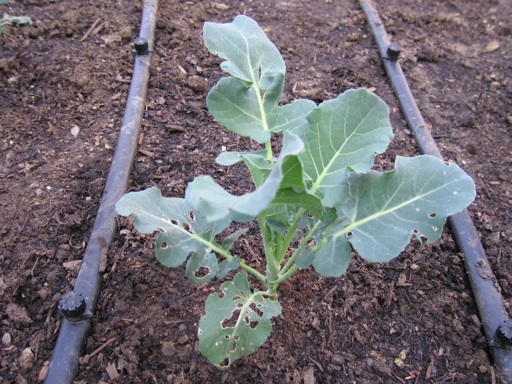
For years, I have attempted to keep snails and slugs away from my strawberry and vegetable plants using 1″ thick copper tape barriers. I have copper tape barriers around all of my strawberry pots and my raised vegetable garden beds. However, I have continued to find many slugs and the occasional snail in my strawberry pots and raised beds. Slugs in particular have been munching on our broccoli plants in the past few weeks, as you can see in the above picture.
The copper tape hasn’t deterred the slugs at all and has not entirely deterred the snails. The copper tape has tarnished since I put it on, which may have reduced its effectiveness. But I am not convinced that repeatedly applying new copper or cleaning the old copper is worth the cost and effort. I have also tried using snail baits in the past, but they have just washed away after repeated waterings and need to be reapplied too often.
I have recently resorted to hand picking snails and slugs out of our garden. It’s especially easy to remove them by hand this time of year, because our vegetable garden is not completely planted yet, and the plants we have set out so far are still small. Snails and slugs move out of their daytime hiding places after dark and are easier to locate then. So I have been going out into our yard a few hours after dark several nights a week with a flashlight to remove all of the snails and slugs I can find. I think that I have reduced the population substantially for now, because I have not seen any more damage to our broccoli or to the tomatoes and peppers I just planted.
Hand removal may be the most labor intensive way to deal with snails and slugs. However, I am beginning to think that hand removal combined with reducing the number of places they can hide to make the yard a less conducive place for them to live is perhaps the best overall solution to dealing with snails and slugs. Snails and slugs like to hide in moist and/or dark places in the daytime. Slugs tend to hide under pots in our yard where it remains moist all the time. The snails tend to hide in lilies such as callas, day lilies, and lilies of the nile, as well as other bushy moist plants that have low hanging leaves. I have removed most of the day lilies and all of the lilies of the nile we used to have. I also pulled up many of our callas, but the ones I left in the ground have proliferated. I am also thinking about reducing the number of pots in our yard.
Going forward, I plan on continuing to perform the hand removal technique after dark once or twice a week. I am hoping that this frequency will be enough to keep the population in check. In the past, I have basically relied on some technical solution to solve the problem for me without much follow up on my part. But I am now realizing that these pests require more involvement by a gardener actively monitoring growing plants for pest damage and taking steps to mitigate the damage as soon as it is discovered.
March 25 2010 | Garden Pests and Vegetables | Comments Off on Snails and Slugs
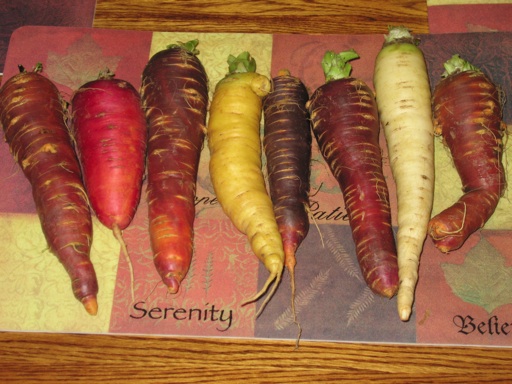
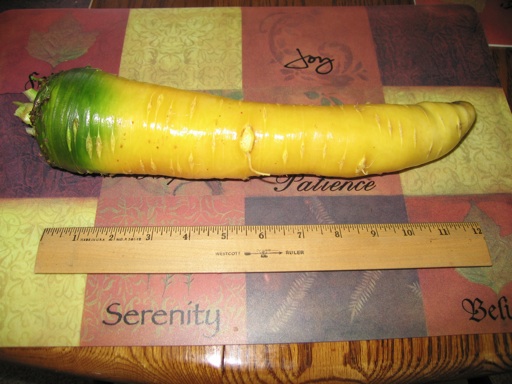
Last spring, I planted rainbow carrot seeds in our vegetable garden. I planted a second crop of rainbow carrot seeds in our garden last September. This week, I harvested the remaining carrots from the spring crop. The first picture above shows some of the red, purple, white, and yellow carrots I harvested. The only color of carrots I didn’t harvest was orange!
These carrots had been in the ground a long time (nearly 10 months). Many of them had grown to be very large. And I don’t remember ever fertilizing them. They don’t seem to need it. Carrots are one of the lowest maintenance vegetables that I have grown. The carrot in the bottom picture has a green top, because that part of the carrot was protruding above the ground.
I have heard that carrots can be left in the ground over the winter, and that the cold winter weather stimulates them to get sweeter. This week we received nearly 6 inches of rain. So I decided to harvest the rest of the spring carrots, because I was concerned that they might start rotting in the ground. In fact, some of them already had a few brown spots.
Some of our carrots were forked. Carrots tend to get forked when their roots run into rocks or hard dirt clods. Also, some of our carrots had split open, possibly because of too much watering during the growing season. But one of the nice things about vegetables is that even the less than perfect looking ones are still edible. Once they are sliced and cooked, who can tell the difference anyway?
January 24 2010 | Carrots | Comments Off on Winter Rainbow Carrots
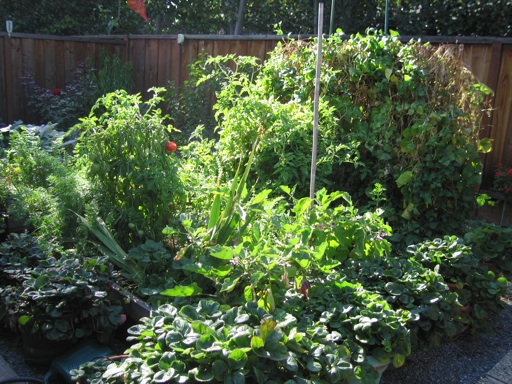
It may not be possible to produce 100% of one’s fruit and vegetable needs in a suburban backyard garden. But after my second season of growing a vegetable garden, I have been thinking about exactly how much our vegetable garden has reduced our food bill.
Below I have listed the approximate amount of produce we have grown this year in our vegetable garden and the cost to buy the equivalent amount of produce in a local grocery store. The prices that grocery stores charge for produce vary greatly from store to store, from region to region, and at different times of the year. The prices per pound of the various items of produce I have described below are approximate average prices that grocery stores in my area have charged this year.
This year, for example, our strawberries produced about a 1 pound of berries per week from mid-May through mid-August and about 0.25 pounds per week after that through the present. Strawberries typically cost at least $3 per pound in our area in the spring, summer, and fall. That’s at least $50 worth of strawberries.
We harvested at least 35 pounds of tomatoes this season. At a price of $2 per pound, that’s about $70 worth of tomatoes. We turned most of those tomatoes into a pizza sauce that we use on homemade pizza as well as in pasta dishes.
We have harvested and eaten about 14 pounds of green beans from late June until now. That doesn’t include the dried beans I harvested last week. At a price of $2.50 per pound, our plants have produced about $35 worth of fresh green beans.
We have grown about 30 carrots that weighed about 15 pounds. At $1.20 per pound, that’s about $18 worth of carrots. We harvested at least 20 zucchinis. At $2 per pound, that’s about $40 worth of zucchinis from our garden. We picked about 8 pounds of eggplants. At $3 per pound, that equals about $24 dollars worth of eggplants. We harvested about 10 pounds of onions that would have cost about $13 to purchase. We also harvested about $10 worth of bell and jalapeno peppers, about $10 worth of basil, about $10 worth of corn, about $5 worth of broccoli, and about $5 worth of spinach.
That equals a total of about $290 worth of produce from the vegetable garden we planted in our yard to replace a 10′ x 20′ lawn. I estimate that I spent about $120 to buy fertilizer, seeds, transplants, and other supplies to start and maintain our vegetable garden this year. It’s hard to estimate how much of our water bill comes from watering the vegetable garden, but a really rough estimate is about $25 from April through October.
Subtracting out the costs, our vegetable garden netted us about $145 dollars this year. That does not amount to a tremendous savings on our food bill. However, gardening is perhaps one of the few hobbies that saves a hobbyist money rather than costing the hobbyist money. Also, I figure that I can increase our yields next year by cutting out some of the plants that did not produce quality produce, like honeydew melons, and planting more of the plants that were easy to grow and inexpensive to plant by seed or transplant, like carrots and onions.
The yield from our pepper plants this year was disappointing compared to last year and prior years when we grew them in pots. This year, our peppers got crowded by the nearby tomatoes and beans. I think I can get them to produce more next year by giving them more room to grow and by fertilizing them more. Optimistically, I think that our vegetable garden, which consists of a 6′ x 7′ raised bed, a 6′ x 8′ raised bed, and a bunch of pots, has the potential to produce $400-$500 dollars worth of produce in a good year at today’s prices.
October 11 2009 | Vegetables | Comments Off on How Economical Is a Vegetable Garden?
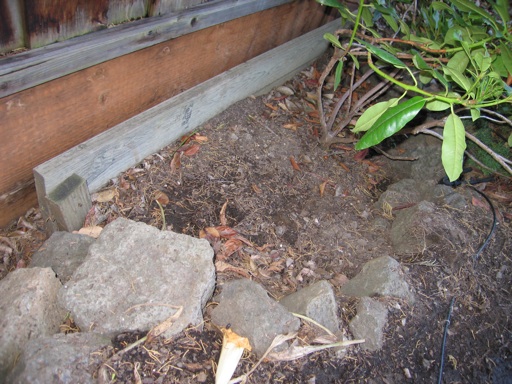
I came across this interesting article in a local publication recently. It discusses the use of wood treated with chromated copper arsenate (CCA) in garden beds. Wood is treated with chemicals such as CCA to kill microorganisms and insects that can cause the wood to decay. The article discussed the possibility that people who build their vegetable gardens using wood treated with CCA might end up consuming arsenic that leached into the soil from the wood.
In 2004, the Department of Soil, Water, and Climate at the University of Minnesota published a study of vegetables grown near wood that has been treated with CCA. In the study, the researchers discovered that plants grown within a few centimeters of CCA treated wood absorbed significantly greater concentrations of arsenic than plants grown several feet away from the wood. Although they concluded that based on U.S. Public Health Service standards these vegetables would be safe for human consumption, they also stated that some of the vegetable crops may not be safe for sustained consumption based on the US EPA’s standard.
In 2004, the Environmental Protection Agency (EPA) in a voluntary agreement with industry began restricting the use of CCA in treated timber in residential and commercial construction, with some exceptions.
However, just a few weeks ago, I discovered a piece of lumber in my yard (see above picture) that had a yellow tag stapled onto it. The lumber was placed around a raised bed near our fence by the previous owners of our house. The yellow tag indicated that the wood had been treated with CCA. I had a rosemary bush growing next to that piece of lumber for years. I also have two orange bushes growing about 6 feet away from it. Based on the results of the University of Minnesota study, I think that our oranges are far enough away from the treated lumber to have avoided absorbing much arsenic from it. But I have pulled up the rosemary bush, and I plan on removing the treated piece of lumber soon.
September 19 2009 | Vegetables | Comments Off on Arsenic in the Garden
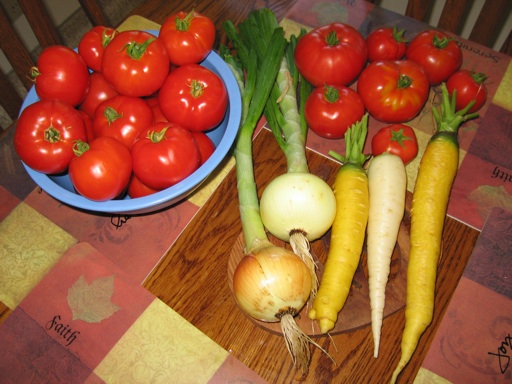
As shown in this picture, we harvested yellow and white carrots, walla walla onions, a bunch of big beef and early girl tomatoes from our vegetable garden today. We are making homemade pizza sauce, minestrone soup, and vegetable lasagna with our harvest. We saved money by growing many of the ingredients for these recipes ourselves, and all of these vegetables were easy to grow. Beyond planting in the spring and then harvesting months later, maintaining our vegetable garden did not require a lot of effort.
The automatic watering system in our vegetable garden saves us the trouble of having to water regularly. I fertilized multiple times after planting. But once the plants started growing rapidly, I figured there wasn’t a need for much additional fertilizer. And I only needed to do a little bit of weeding. I think that the weeds just didn’t get a chance to grow, because I planted the vegetables relatively close together. Once the vegetable plants started to grow together, there wasn’t much sunlight to stimulate weed growth in between them.
I just planted another set of carrot seeds. July and August is the time to plant carrot seeds for an autumn and winter harvest. One nice thing about carrots is that they hold well in the ground after they reach maturity without rotting or losing quality. That means you can leave them in the ground for months until you are ready to harvest them.
July 26 2009 | Carrots and Onions and Tomatoes | Comments Off on Summer Harvest
« Prev - Next »





